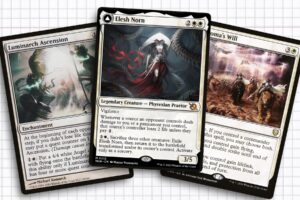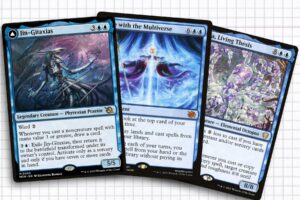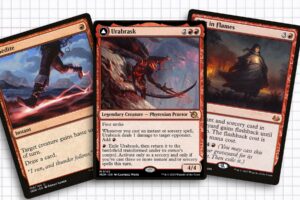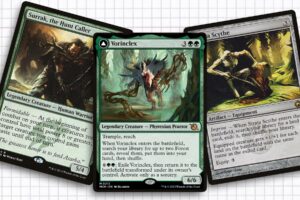March of the Machine is finally here, and while I am far from the biggest acolyte of New Phyrexia, I can freely say the praetors have proven to be iconic characters within Magic: the Gathering’s lore. Which is why it’s disheartening to see they have fallen, due to poor planning on the part of the Mother of Machines. So if the cycle coming out of March of the Machine is in fact going to be the last time we see these characters in a chronological sense, I think they are due their own memoriam.
It shouldn’t be controversial to say this cycle of praetors is not the most powerful versions of these characters. But, I believe their double-faced nature makes them fertile ground for exploring possibilities as commanders. Not being asymmetrical, I believe these five promote a slower, more casual game of Commander. That is why today, I want to speak briefly on each member of the March of the Machine praetor cycle, theorycrafting a deck skeleton that could serve as the inspiration for an expanded deck in the future.

Elesh Norn
Of the five commanders we will be discussing today, Elesh Norn has generated the most clear mental picture for me. I see Elesh Norn like a twisted version of Bitterblossom. Hhe deck feels like a perfect time to bring out our copies of Luminarch Ascension and start producing tokens, to help protect our life total and tax our opponents. Our selection of tokens should fly wherever possible, so keeping an eye out for token producers like Geist-Honored Monk and Twilight Drover will compliment Ascension well. Token doublers Anointed Procession and Mondrak, Glory Dominus should put us over the top. Lastly, since these tokens can be fragile versus the swarms of creatures on hand for our opponents, spells to make our team indestructible. Akroma’s Will, Flawless Maneuver, or Rootborn Defenses, will be instrumental in helping us get the reach and staying power we need to be competitive.
I find The Argent Etchings to not be as inspiring as the creature side of this commander. But, once we’ve moved past taxation and started to use the tokens as our mechanism for transforming Elesh Norn, having a suite of phyrexian cards on hand in the vein of Defiler of Faith, Mite Overseer, Phyrexian Awakening, and Phyrexian Censor is going to make chapters two and three of The Argent Etchings punishing and explosive for the rest of the table. It will be a common theme amongst most of the deck skeletons drawn up today, but proliferate in the form of a staple like Throne of Geth is going to be so helpful in running through saga chapters at the desired pace we need.
For a brief time, I also thought leaning into life gain was going to be a counterweight to the damage we would be courting, as opponents will likely value swinging with larger creatures if that damage is going to cost them life or mana. But I believe it may not be all its made out to be, as a lot of lifegain tools won’t survive the third chapter of The Argent Etchings. It might, in fact, be better to simply tax our opponents more with God-Pharaoh’s Statue and Isolation Cell, since they can come down, do their job, and hopefully outlast the removal in our opponents’ hands.
Jin-Gitaxias
Wizards hasn’t given us a legendary creature like Jin-Gitaxias, with the exceptions of maybe Brinelin, the Moon Kraken or Thryx, the Sudden Storm. But Gitaxias feels different still. This cares about the mana value of spells, to draw cards and works towards The Great Synthesis. I am not an especially competent spellslinginger pilot, which is probably going to make this deck harder for me to mentally construct.
As I see it, spending the first few turns dropping mana rocks and synergy pieces like Archmage Emeritus, Defiler of Dreams, and Teferi’s Ageless Insight to help keep our hand size full is going to go a long way towards reaching out desired game state. Our goal is transforming Jin-Gitaxias, and possibly taking two attempts at storming off. In this way, I see Jin-Gitaxias playing a lot like The Locust God during some turns, but without the built-in creature swarm.
Now, once we reach The Great Synthesis, do I really think we’ll be hoping to cast a whole host of spells and mill someone out with a Brain Freeze? Not really, but I would love to bring together spells like One with the Multiverse, Shark Typhoon, and Swarm Intelligence. I want to see what chaos we can create with Octavia, Living Thesis in play. And maybe, we have a Hindering Touch in the deck list; pure premodern bragging rights. And while any of the praetors would probably enjoy having one of their past incarnations in the deck, I think Jin-Gitaxias, Progress Tyrant makes a seamless translation into a second-in-command. The Kamigawa: Neon Dynasty version duplicates our spells and clogs up our opponents as they carefully sequence their spell
Sheoldred
Sheoldred feels like a Tergrid, God of Fright substitute which will allow you to still have friends after the game ends. Of the five, this deck may want to be churning through chapters on the regular the most, then taking the turn to attack with Sheoldred, before transforming to keep the engine rolling as much as possible. I don’t even have a unified direction to go in. We may not even need to concern ourselves with maximizing the potential creatures we’re reanimating. We hit chapter three every time, instead working to keep our opponent’s hands on the low and milling them out, even if that’s not our core win condition.
The graveyard size requirement to transform this general gave me happy memories of playing Avatar of Woe in the lunch table meta. I instantly knew a few of the choice spells I would be looking to arm this deck with. I haven’t been able to pack a deck with Altar of the Brood, Dread Summons, and Mindcrank since The Mimeoplasm. It’s been too long. I wanna do fun shenanigans with Waste Not. I want to see if Lord of the Forsaken can work in combination with Dictate of Erebos to fill up the graveyards. Want to say I activated Contagion Engine to read all three chapters of The True Scriptures in one turn, at least once.
Of all the decks I spotlight today, this one might run with the least amount of creatures, simply because it plays as an aikido deck; using the threats of your opponents against them. It will probably be a miserable experience for everyone else at the table, but it all sounds like some much fun, in an inefficient way.
Urabrask
At this point, we are led to believe that Urabrask may be the only surviving New Phyrexian praetor. The second spellslinger deck of the day, blueprint for an Urabrask deck is going to take a lot of notes from Zada, Hedron Grinder. By filling the deck with cantrips, like Crash Through, Expedite, Rile, and Renegade Tactics, you could chain together the requisite spells needed to transform Urabrask and launch an Anger of the Gods at one player and their creatures.
But even assuming that we are trying to create a board state where we can transform our commander as often as possible, it seems a little short-sighted. The ability on Urabrask to deal a damage every time we cast an instant or sorcery while creating a mana could allow us to transition in a burn deck, using Torbran, Thane of Red Fell and Fiery Emancipation to string together large swaths of spells and damage. Maybe we shuffle our graveyard back into our library with Elixir of Immortality, Feldon’s Cane, and Perpetual Timepiece. It’s an imperfect idea, but I think there is something to consider here.
Once we do consider The Great Work, I believe being able to play the politics. We board wipe one player during chapter one, which makes for a strong few turns going forward. There is solid work to be done with this saga, but I think it is the one I would want to have the most concrete game state possible to benefit from what it’s doing during it’s later chapters. I really want to have chapter three be this very explosive turn, but I also know it’s dependent on what I build into the deck along with what my opponents have equipped themselves with. Additionally, I am aware that my previous game plan in which I shuffle away my graveyard is going to be counterintuitive to chapter three of the great work. But, once again I’m thinking it comes with developing knowledge of what this deck is trying to do, and how important our own graveyard will be moving forward.
Vorinclex
Vorinclex feels like the most old school of the praetors on the creature side. Because of this, I feel like we can play off of the ramping they will do, with equipment on hand, such as Blackblade Reforged, Staff of Titania, and Strata Scythe. This makes him into a solid Voltron general which can flip over to the opposite side to work as a board wipe. Additionally, The Grand Evolution is the saga I feel I would like to proliferate through on command as much as possible.
The ramping natural to Vorinclex also means we can invest in big mana creatures like Apex Devastator and see a lot of pay off. In the early turns, I would be setting up with Drumhunter and looking to get a Surrak, the Hunt Caller onto the battlefield. This is to rush a victory on the regular. And because the final stage of The Grand Evolution grants activated fighting, Bow of Nylea allows you to attack and then take out any number of problem targets before blockers can be declared. If you’re a player looking to balance voltron and creature swarms, I feel Vorinclex may be a perfect commander to test a build out with.
I love the flexibility on display from each of the commanders. They use the saga side to ensure effects most other commanders would need to rely on half a dozen other slots to have on hand. These praetors are going to facilitate a slower gameplay loop, since transform into the saga side is completely left at sorcery speed. And while by design most of the time you will be working your way through each chapter one turn at a time, I think proliferate spells are going to do a lot of work to give each praetor some sense of agency.
This slower gameplay loop is going to be something I will really be enjoyed by players who are not rushing to complete as many games of commander in a night as possible. If you’re a player looking to see turn 15, I hope I have supplied some fertile ground for a deck idea to spring out of. Until next, thanks for reading.
Ryan Sainio (he/him) is a Graphic Designer exploring the Commander format and Magic history on a regular basis. Notable decks that value flavorful and fun gameplay over competitively optimized decks include Shattergang Eldrazi, Doran Soul Sisters, and Chatterfang ProsBloom.
MTG Content Creator Awards 2022 nominee: Format Specialty Writing & Excellence in Writing Overall




